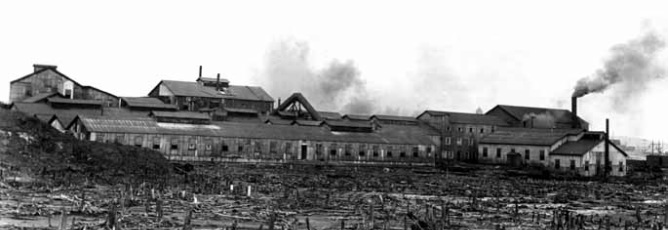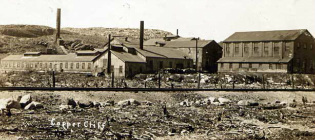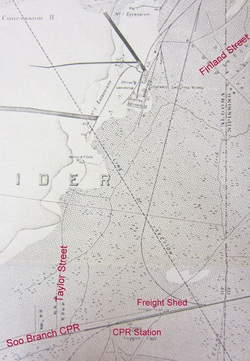Orford Village
In 1900 the Ontario Smelting Company, a subsidiary of the Orford Copper Company. erected a new plant, the Ontario Smelting Works, to treat and upgrade the Canadian Copper Company matte before shipment for refining at the Orford Company refinery at Constable Hook, New Jersey. Located at the foot of what is now Cobalt Street in Copper Cliff, the plant was referred to as the old Cobalt plant, although it never produced cobalt.
|
After the formation of the International Nickel Company in 1902 this plant was taken over by the Canadian Copper Company, a predecessor company of Inco. Later, in 1904, it was partially destroyed by fire, the same year that the old West smelter suffered a similar fate.
A small housing program associated with the Ontario Smelting Works (OSW), southwest of the Copper Cliff Mine, became known as the Orford Village. It included the Orford Club and residences on Taylor Street. The Orford settlement has since disappeared. |
|
In 1911 Orford Village was located north-west of the CPR Station. Residents were:
By 1916, the name of Orford Village was changed to Taylor Street In 1920, the only two residents were John S. Jackson who lived at No. 7 Taylor Street and Frank J. Stubbington who lived at No. 8. John and Frank worked for International Nickel In 1930 Hugh Stubbington lived at No. 6 and John Jackson lived at No. 7. By that time John worked for Fraser-Brace. In 1934 the only resident was Elsie B. Jackson. |
Frank Stubbington, Prospector and Geologist
Francis John Stubbington was born August 24, 1848 in Bishops Waltham, Hampshire, England. He died March 17, 1919 in Copper Cliff. He was married may 18, 1875 at Yeovil, Somerset, England to Mary Bennett, born July 16, 1853 in Yeovil, Somerset.
At the time of their marriage Francis John Stubbington, 26 years old, bachelor, an engine fitter living at 3 Derby Street in St. George's Bristol. His father was John Stubbington who worked as a gardener. His witness was Adolphus Linnett. Mary Bennett, 22 years old, spinster, living at Bond Street in Yeovil. Her father was William Bennett, a tailor. Her witness was Elizabeth Bennett. They were married in the Wesleyan Chapel according to the rites of the Wesleyan Methodists.
Their children were:
From the 1891 Census of McKim, Francis Stubbington Jr, age 42, born about 1849 in England, his wife Mary, age 37, daughter Mabel, age 15, son Ewart Morley, age 13, daughters Edith Gertrude, age 11, Edna Mary, age 7, Dulcibel, age 4, born in Ontario and son Francis Bronson born in Ontario
From the 1901 Census of Snider and Waters Township, Frank Stubington, age 52, born August 24, 1848 in England, immigrated in 1885, occupation farmer, his wife Mary, age 47, son Ewart M, age 22, general labourer, daughter Edith G., age 20, general servant, Edna M., age 16, Dulcibel M., age 13, Francis B, age 10 and Elsie M., age 6.
At the time of their marriage Francis John Stubbington, 26 years old, bachelor, an engine fitter living at 3 Derby Street in St. George's Bristol. His father was John Stubbington who worked as a gardener. His witness was Adolphus Linnett. Mary Bennett, 22 years old, spinster, living at Bond Street in Yeovil. Her father was William Bennett, a tailor. Her witness was Elizabeth Bennett. They were married in the Wesleyan Chapel according to the rites of the Wesleyan Methodists.
Their children were:
- Mabel Stubbington born December 19, 1876 in Gloster, England; died July 21, 1957 in Sudbury; married William N. Bucknam November 18, 1896 in Waters Township, Nipissing
- Ewart Morley Stubbington born in 1878
- Edith Gertrude Stubbington born 1880 in Somersetshire, England; married William Burgess Hall July 30, 1902 in Waters Township, Nipissing
- Edna Mary Stubbington born in 1884; married George Alexander Dods at Algoma June 8, 1907
- Dulcibel Maria Stubbington born 1887. At the time of her birth, Francis was a geologist.
- Francis Bronson Stubbington born in 1891 and died October 20, 1918 of Spanish influenza
- Elsie Mildred Stubbington born in 1894; married Harry Avnell Smith July 21, 1925 at Copper Cliff
From the 1891 Census of McKim, Francis Stubbington Jr, age 42, born about 1849 in England, his wife Mary, age 37, daughter Mabel, age 15, son Ewart Morley, age 13, daughters Edith Gertrude, age 11, Edna Mary, age 7, Dulcibel, age 4, born in Ontario and son Francis Bronson born in Ontario
From the 1901 Census of Snider and Waters Township, Frank Stubington, age 52, born August 24, 1848 in England, immigrated in 1885, occupation farmer, his wife Mary, age 47, son Ewart M, age 22, general labourer, daughter Edith G., age 20, general servant, Edna M., age 16, Dulcibel M., age 13, Francis B, age 10 and Elsie M., age 6.



